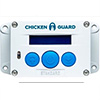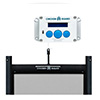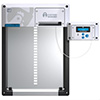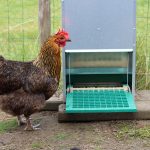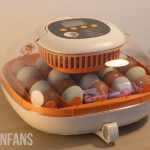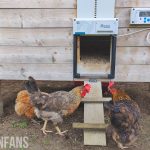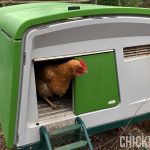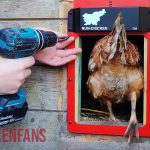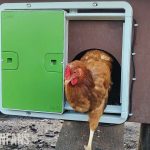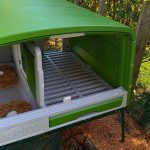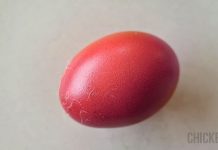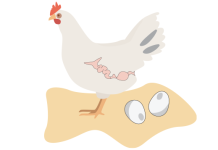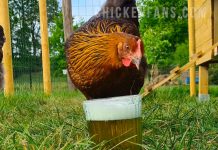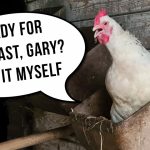ChickenGuard Automatic Chicken Coop Door Review (2025)
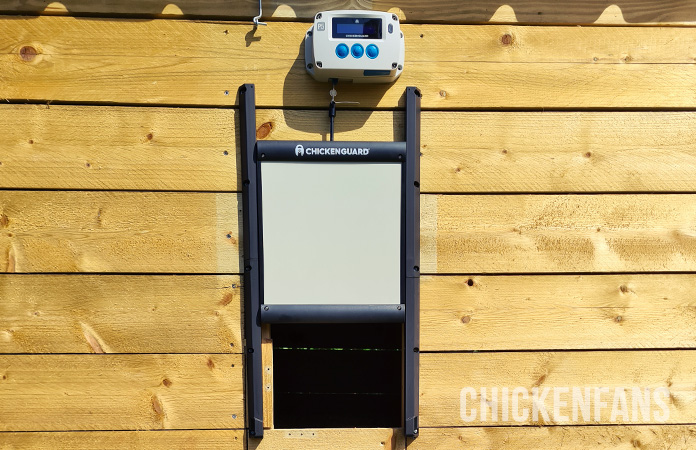
Chicken Fans is reader-supported. When you buy through our links, we may earn a commission. Learn more about our privacy policy and disclaimer.
ChickenGuard is one of the go-to brands for chicken coop doors of many chicken keepers worldwide. We take their doors to the test.
Automatic chicken coop doors are the best invention since sliced bread. Every chicken keeper will eventually look for an automatic chicken coop door to ease their life. You can sleep as long as you want and you don’t have to worry if you’re home late.
- Easy installation
- Rigid aluminum door
- Clean design
- Light Sensor & Timer
- Difficult to read the display in sunlight
- Batteries in the box drain quickly
- The screws in the box tend to rust
Overview
ChickenGuard is a very well-known manufacturer of automatic chicken coop doors and door openers. They are one of our top brands to compete in our Best Automatic Chicken Coop Door review and are the best all-purpose chicken coop door because of their versatility.
To accommodate a wide range of poultry flocks, ChickenGuard ships automatic chicken coop door openers with timers and light sensors, as well as door openers for heavy doors and extreme weather conditions.
The standard ChickenGuard chicken coop door and opener are versatile enough for most people. We examine each model, discuss the materials involved, and assess how predator-proof the door actually is. We also tackle the ease of installation, what comes in the box, and how you can use the motor units in several different setups.
- Make sure you have a door + door opener, as they are also sold apart
- The right door rail can be tricky to install when you’re alone
Design
The door is a guillotine-style aluminum gate that slides smoothly and is guided by two plastic runners. Compared to some of its competitors, the door has a sleek and unobtrusive design.
ChickenGuard doors come in two parts:
- The Chicken Coop Door: the actual self-locking door
- The Chicken Coop Door Opener: the motor unit opening and closing the door
In 2023, ChickenGuard launched a new chicken coop door, the All-in-One model. All other series remain available, so you can choose which door suits your needs best.
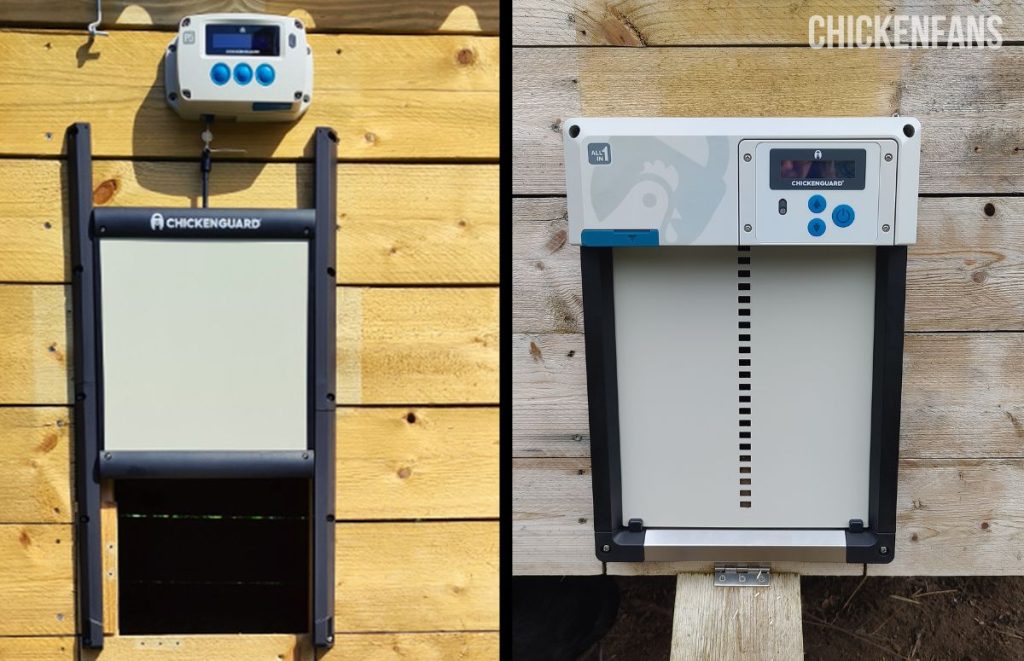
Self-locking Chicken Coop Door
The standard ChickenGuard coop door has a self-locking mechanism that engages when the door closes. The lock itself is not a mechanical lock but is triggered when the lever on top of the door sinks in when the door is completely closed. That way, the locking mechanism doesn’t use any power from the battery.
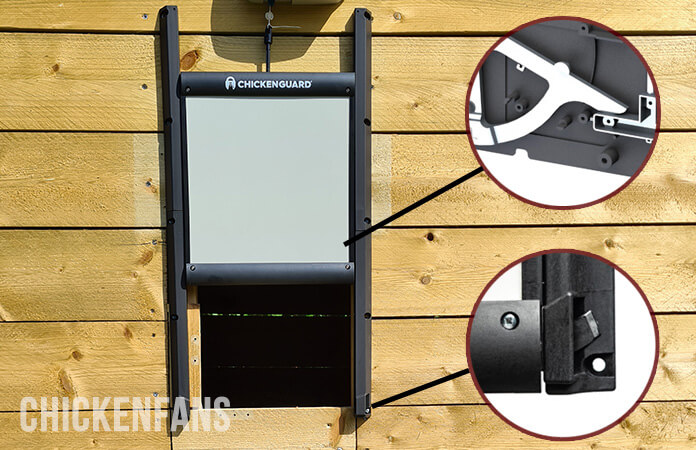
Most people mount the door on the outside, but it can also be installed inside the coop with the control panel on the outside. You hide most of the machinery that way, but it might be challenging to do in a smaller coop. The door sits pretty tight to the surface, and there is almost no visible gap between the door and the coop.
Door Materials
Only the door’s core is aluminum; the rest is 100% recycled plastic. Although the plastic runners do their job, they don’t feel too rigid, especially because they come in two parts. If you have a wooden coop that’s not entirely flat, make sure to use all screws to put the rails in place.
ChickenGuard also ships a full aluminum door with an English oak runner kit if you’re not fond of plastic. The door is sturdy, has a modern and clean look, and is about 2 inches wider and 4 inches higher.
Chicken Coop Door Opener
ChickenGuard produces several door openers for different purposes. Some come with a light sensor, and the extreme versions are built for heavier coop doors. However, apart from a small label on the unit, they all look exactly the same.
The unit has a small screen to guide you through the menu. The display can be challenging to read when there is plenty of sunlight.
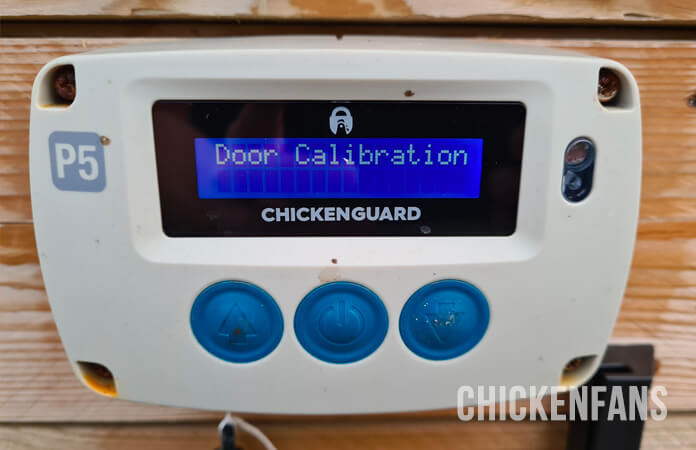
The door openers are mounted with four screws and have a front and back panel. The back panel contains a spindle that winds up the cord, and the front panel holds 4XAA batteries. Two small wires connect the front and back.
ChickenGuard Door Opener Series
ChickenGuard delivers four versions of its door opener:
- ChickenGuard Standard: the basic unit for an automatic chicken coop door
- ChickenGuard Premium: the basic unit + an adjustable light sensor
- ChickenGuard Extreme: the premium unit + an extra powerful motor
- ChickenGuard Pro: brand new Premium and Extreme unit combo
However, at this moment, ChickenGuard focuses mainly on selling only three products:
- ChickenGuard Standard
- ChickenGuard Pro
- ChickenGuard All-in-One
You can still purchase the Premium and Extreme versions, but the company chooses to focus on selling the new combined version of these two models, the ChickenGuard Pro.
You will still find an ECO model of the ChickenGuard door opener on some webshops, but those are old models as they aren’t on the market anymore.
The openers are mostly sold separately from the coop door. Some vendors advertise with the wrong marketing pictures, which can trick you into buying a single unit when you think you’re purchasing a combi pack containing a door.
Here is a comparison table of the ChickenGuard Door Openers.
| ChickenGuard | Standard (S) | Extreme (X) | Pro | All-in-One |
|---|---|---|---|---|
| Open & Close Manually | yes | yes | yes | yes |
| Open & Close with a Timer | yes | yes | yes | yes |
| Open & Close with a Light Sensor (LUX) | no | yes | yes | yes |
| LCD Display | yes | yes | yes | yes |
| 4 x AA batteries | yes | yes | yes | yes |
| Electric powered via USB (Alternative) | yes | yes | yes | yes |
| Door closed indicator | yes | yes | yes | yes |
| Low battery warning | yes | yes | yes | yes |
| 3-year warranty | yes | yes | yes | yes |
| Maximum door weight | 2.2 lb (1kg) | 8lb (4kg) | 8lb (4kg) | 8lb (4kg) |
| Weather Temperatures | 14°F (-10°C) | -4°F (-20°C) | -4°F (-20°C) | -4°F (-20°C) |
| Winter Mode | no | no | no | yes |
The Extreme model is made for extreme weather conditions, like Canadian winters or summers in Death Valley. They are manufactured with military grades, and the electronics are fully encapsulated in epoxy resin.
Starting from the Premium model, all openers come with both light sensors and timers. You can configure the light sensor and timer together so that the automatic door will close at a specific time, even when it’s still overly light outside.
New Features of the P5 / X5 / S5
ChickenGuard has upgraded its door openers with a couple of extra features. For those that are familiar with the old units, these new features might be interesting:
- Automatic Door Calibration: the unit has a door calibration function that can automatically detect the open and closed positions, so you don’t have to manually configure them anymore
- Automatic Stop: the door automatically stops in case of an obstruction. This prevents your chickens from getting trapped when the door lowers. It will also stop when there is another obstruction, like ice or straw on the rails. This prevents the string from getting tangled and the lock wings from getting out. We’ll discuss this in detail with a video to demonstrate the feature.
- DC Power Unit: you can swap out the 4xAA Alkaline batteries for a DC power supply (9V or 12V), but the cables of the power supply are not included in the box
- Battery Warning Light: the door opener has a LED light mounted that will light up when the battery runs out. According to the documentation, the light should be visible from 100 meters away, but that’s probably at night. The LED is not that visible in direct sunlight (which is perfectly normal).
- Backup Lithium Cell Battery: it’s possible to add a CR1220 Lithium cell battery in the unit that prevents the clock from stopping when you change the batteries. The lithium battery is not included, but you might insert one if you have some spares in a drawer.
- Self-Diagnosis Mode: the unit has a self-diagnosis mode that shows an alert message when something goes wrong. It also shows a message on the display that will guide you in solving the issue. We have an example video below to show what happens when the door gets stuck midway and how the unit’s self-diagnosis reacts.
Predator Proofness
The rigid plastic and aluminum of the standard ChickenGuard door set keep most predators like foxes out. The door’s surface is flat, and it’s the last place predators will try to bite through.
The door has a locking mechanism that automatically latches when the door closes. This prevents predators from lifting up the coop door. The door locks on both sides with anchor wings.
Closing the Bottom Gap
When the door is closed and locked, there can still be a very small gap, and the lock wings are still approachable from the sides. Smart predators like raccoons can open hook-and-eye latches with basic handles.

If you want to completely rule out raccoons, ChickenGuard recommends adding a stripboard in front of the bottom runners. This will prevent the animals from pushing the side wings to unlock the lever.
Locking Issues in Old Units
There used to be one flaw in the locking design. However, we could no longer reproduce this issue with the new door-opening modules. We’ll discuss the issues so you know what to look for if you buy a second-hand unit.
If you have an old unit and the door gets stuck halfway, the cord keeps going and engages the lock too early. When the door later gets unstuck and drops, the anchors are already in the locking position, preventing the door from going all the way down.
This leaves a gap at the bottom of the door. With the lock levers sitting on the receivers, it’s easy for a predator to stick its nose underneath the door and nudge it open. The chickens are stuck inside and can’t escape the predator, as the door will be closed for them.
Preventing Locking Issues in Old Units
Unfortunately, there is no workaround. If the door gets stuck, the only way to get the door down is to pull up on the lock lever to close the door and get the lock anchors in the side rails. This is, however, not something you want to do every night if you have an automatic chicken coop door.
The only way to prevent this from happening is to regularly double-check for dirt and debris. If you live in a cold climate, check for ice. Greasing the rails is not an option, as it only attracts more dirt into the otherwise smooth plastic runners.
Locking Issues in New Units
In new units, the door will not lock midway when it gets stuck, and the anchors won’t come out. Instead, the motor unit detects that there is nothing pulling the cord and pauses the door.
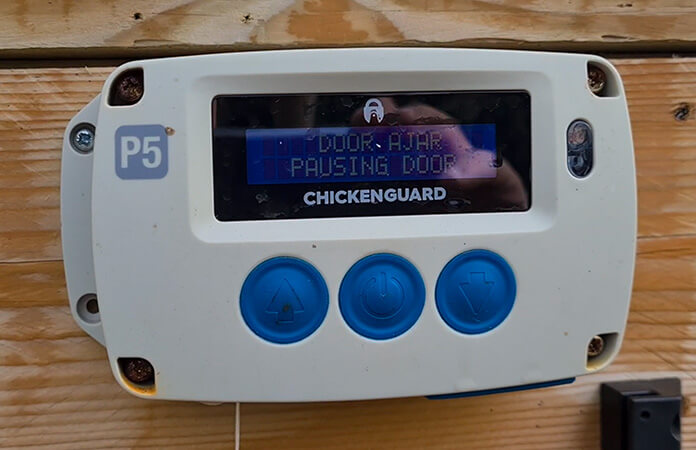
When the door gets stuck, the unit will show the message DOOR AJAR – PAUSING DOOR on the visual display to indicate that the door didn’t shut well. When the door gets unstuck, it doesn’t fall down, leaving a gap on the bottom as it did previously with the older units. Instead, the door stays in the same position, preventing the cord from untangling.
When you get this message, the unit enters its self-diagnosis mode. You won’t be able to further close the door with a simple push of the DOWN button. Instead, it will tell you that the door stopped and that you must re-calibrate the coop door. You can trigger automatic re-calibration after you remove the obstruction. One push on the power button will trigger recalibration, fully opening and closing the door.
We’re not sure if this new behavior is much better. When the door gets stuck, it will stay open, even when it gets unstuck. In case of an issue, the door is left wide open for predators to enter the coop. However, the birds will have at least a way to escape the coop when they are in danger.
In the ideal world, an alarm goes off if the door can’t shut down correctly.
Size
The chicken coop door is relatively small. We had to adjust the entrance to the coop to fit the door. The rails are screwed on both sides of the opening, so the entrance must be smaller than the width of the door.
Here are the sizes we measured after installing the ChickenGuard door:
| Aluminum door dimensions | 10 x 12 inch | 25 x 30 cm |
| Runners length | 23.5 inch | 59,5 cm |
| Maximum width of the opening for the door | 10 inch | 25 cm |
| Maximum height with the door open if the unit is right on top of it | 6 to 7 inch | 17 cm |
| Minimum rail height wasted with the unit right above the door | 4 inch | 10 cm |
| Full Aluminum with Premium Oak Door dimensions | 12 x 16 inch | 30 x 40 cm |
| Premium Oak Runner dimensions | 24 inch | 60 cm |
Here is what the width looks like after installation. You can see we had to put some extra wood in place to shrink the gap.
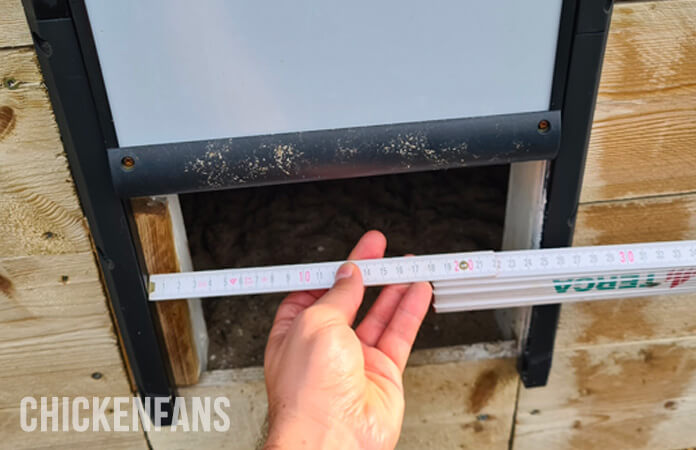
The door can open much higher, but it depends on how much space you have on top of the door. If you place the unit right on top of the door rails, the opening for your chicken is only 6 to 7 inches.
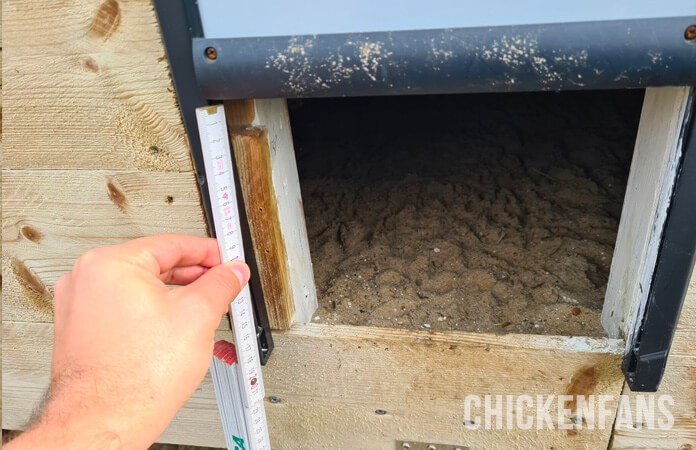
If you place the door opening unit right on top of the door rails, the door can not open all the way to the top. The lock lever and the cord take away about 4 inches (10cm).
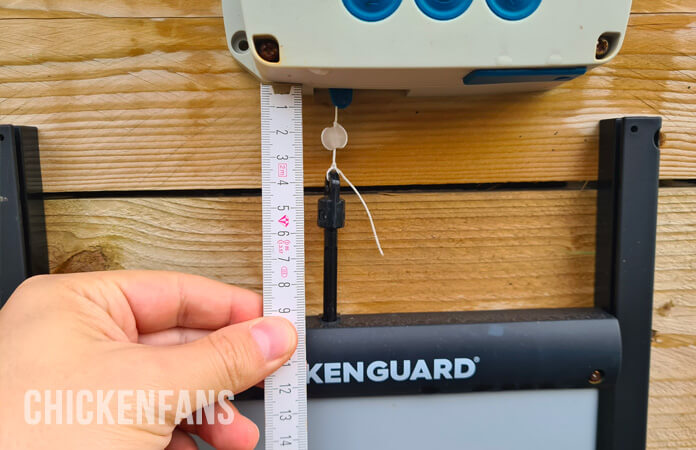
Ease of Installation
Overall, the installation was relatively easy, although the instructions were not always that obvious.
In general, these are the installation steps:
- assemble the guiding rails with the sealed screws
- install the left rail on the surface of the coop right next to the opening
- install the right rail with the door in place to get the dimensions right
- install the door opener and attach the pulling cord to the locking lever
- go through the setup wizard
We’ve made a complete step-by-step ChickenGuard chicken coop door installation guide which explains every step in detail.
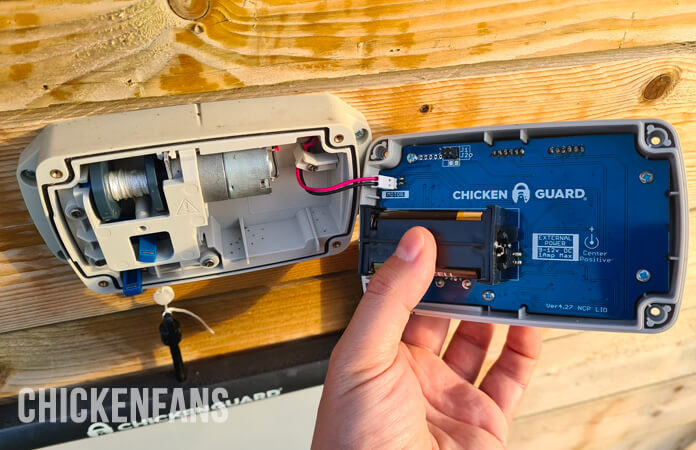
One thing to be aware of is the attachment of the front panel wiring. When you change the order of the black and red cable, the door will go up when you press DOWN, and the door will go down when you press UP.
Noise
The aluminum door does a pretty good job of keeping the noise out. The aluminum reflects the sound waves back into the coop and reduces the noise levels. It’s also a good insulator that will block out noise from the outer environment, so your chickens can sleep.
However, it’s still a thin layer of highly conductive aluminum and will be less effective in blocking out noise than other materials like wood.
Overall, the noise level is reduced significantly when the coop is closed.
Temperature
The standard and premium models can withstand temperatures to 14°F (-10)C), and the Extreme model even down to -4°F (-20°C). We did the test over a number of nights when temperatures were below freezing.
During these nights, temperatures dropped to 17°F (-8°C), and the ChickenGuard closed without any problems. But one night, the door did not reopen in the morning, and the display showed an error message. We had to recalibrate the door before it could reopen again. If you don’t recalibrate the door manually, your chickens can’t get out of the coop.
Therefore, we advise always to check on your hens in the morning during cold weather. You don’t want to lock them up during the day. If you live in a cold area with harsh winters, choose the Extreme model instead of the Premium or Standard.
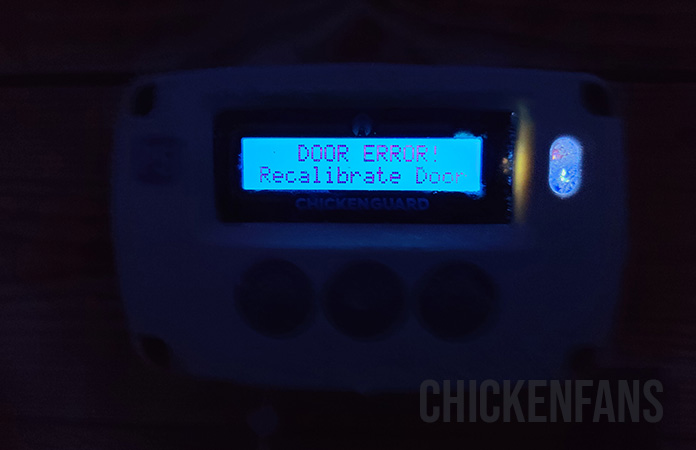
What’s In The Box
ChickenGuard has many door openers and variations that come in different boxes. However, you order either a door opener, a door, or a combination of both the door opener and the door. ChickenGuard has years of packaging experience, and it shows when you get the box.
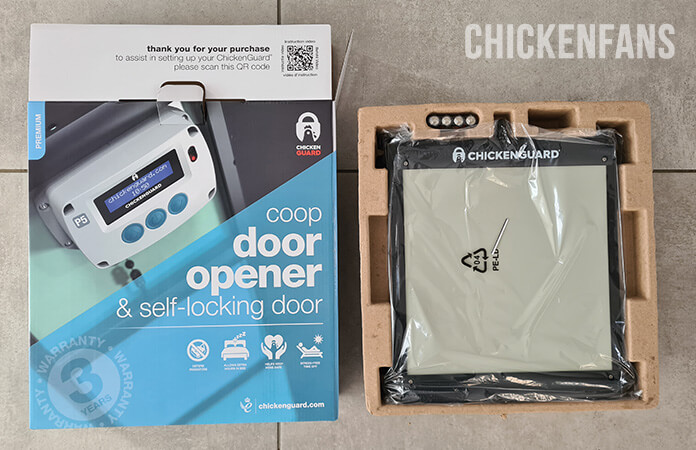
Almost everything you need to install the door is included in the box:
- the door and door rails
- the screws
- the batteries
- the self-locking door kit instructions
- the usage instructions for the door opener
- a warranty card
The only thing not in the box is a USB cable for those who want to power their unit with a USB cable instead of batteries.
This is what it looks like if you buy a combi package:
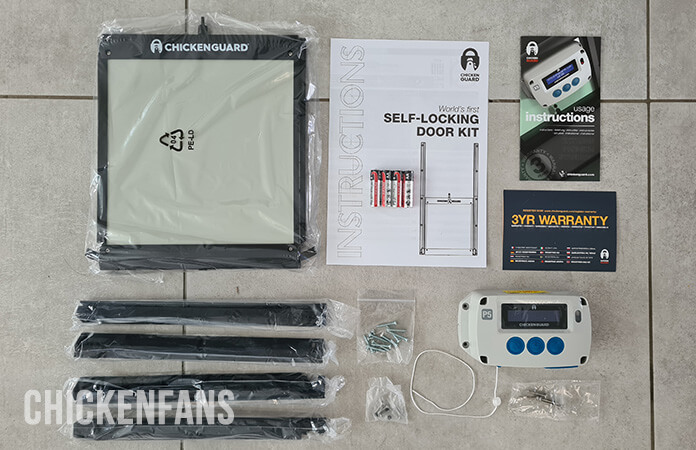
The door is pre-assembled with the locking mechanism in place. The cord is already on the spindle of the motor unit. In our case, the elastic sealing of the front panel was already put in place.
Compared to other vendors, the ChickenGuard automatic door has only a few components to assemble.
Maintenance & Durability
The ChickenGuard chicken coop doors are a popular choice for many chicken keepers, and most of the units withstood the test of time.
The things we like about the design:
- The plastic housing is robust and has elastic sealing to prevent water infiltration
- The locking mechanism does not rely on the battery, which makes it last longer
- The black plastic does not seem to suffer much from decoloration due to ultraviolet in the sunlight
However, there are also a couple of elements that could improve:
- the screws are supposed to be stainless steel, but we can see rust forming on the heads of the screws after only half a year
- the batteries that were included in the box already ran out after three months of operation
You can clearly see the difference between our own stainless steel (inox) screws and the screws of the front panel:
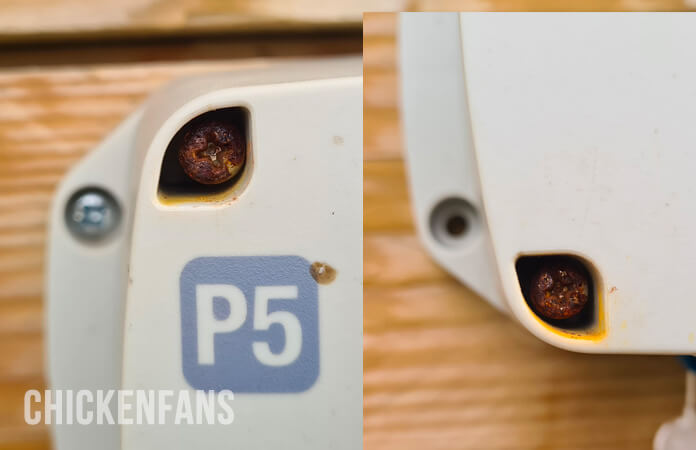
Although the cord seems rather fragile, ChickenGuard claims they only ever had to replace two strings worldwide. In both cases, the string was worn out by rubbing against parts of the chicken coop. The breaking strain of the string is 50lb (25kg), which should be more than enough to carry the standard door.
Door Configurations
If your chicken coop has a special setup or lacks space, you can use pulleys to create a custom configuration.
Here is what you need to know if you decide to customize your setup:
- you can use as many pulleys as you want; it will not drain the battery if the door is the same weight (provided there is not a lot of friction)
- the more pulleys you use, the slower the door will travel
Here are some cases where you can adjust the setup of the chicken coop door.
When you don’t have much space
You need about 30 inches on the coop to complete the installation. That’s 24 inches for the runners of the door and 6 inches for the door opener, with a minimum of space in between. Having the door opener just above the door will also limit the size of the opening when the door is in the highest possible position.
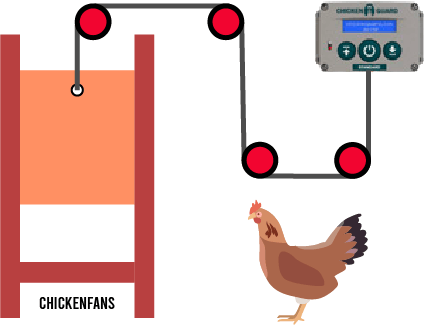
When you don’t have much space, you can use pulleys to put the door opener next to the door. You will need at least four pulleys to get the job done. Always make sure that the cord connected to the door is completely straight. The same applies to the cord that’s attached to the unit.
When you want to put the door opener on another location
If placing the door opener right on top of the door is inconvenient, you can use pulleys to guide the string to another location. It depends on your situation how many pulleys you need.
Here is the simplest situation that could possibly work with keeping the cord straight.
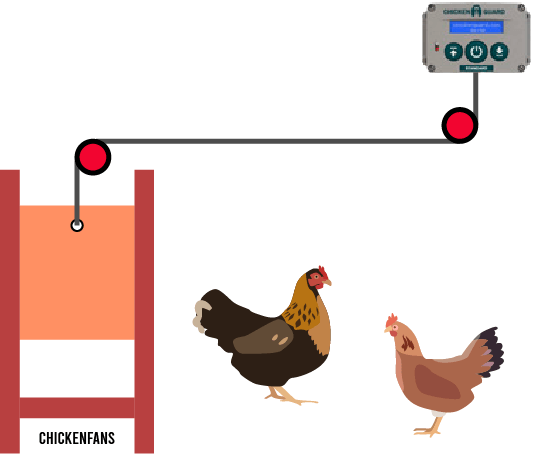
When your chicken coop has a ramp-style door
Even if you don’t use the standard chicken coop door but have a ramp for your chickens to enter the coop, you can use the door opener. Just use pulleys to guide the cord to the door opener, and make sure the cord goes straight into the unit so you won’t run into any problems with the spindle.
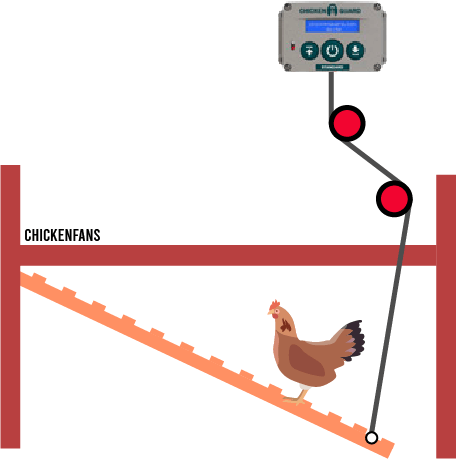
When your chicken coop has an extra wide gate
When your door is much wider, it’s better to have two attachment points to distribute its weight. By attaching a second cord to the original string, you can connect both attachment points to the same door opener as follows.
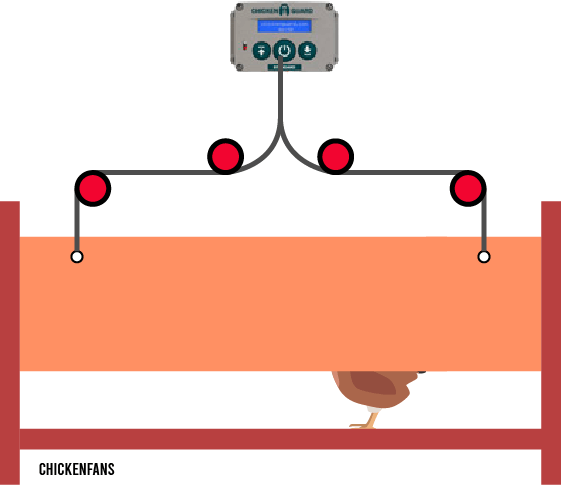
Always ensure to configure the pulleys so that the cord goes straight into the unit.
When you want to pull up two doors at the same time
With the ChickenGuard Extreme, you can handle multiple doors at the same time. Like in the previous situation, you have to attach an extra cord and attach it to the existing one.
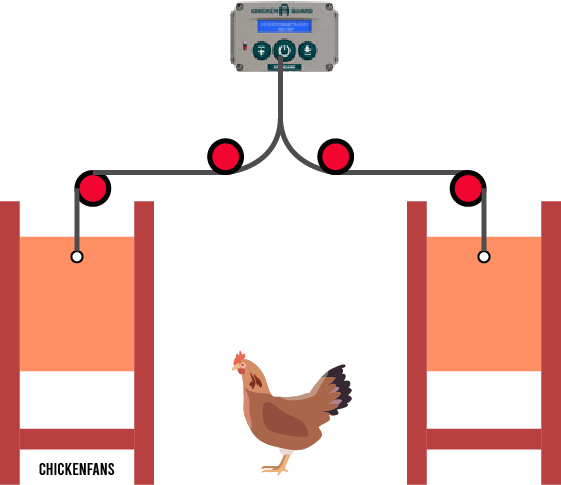
This setup will always open both doors at the same height. Having different opening distances with a single ChickenGuard door opener is impossible.
Price and Availability
ChickenGuard delivers chicken coop doors worldwide. Prices vary and depend on your location.
You typically pay between $150 and $200 for the door openers. If you buy a combi pack, that price can exceed $200. Although it’s plenty of money compared to other poultry materials, the doors are competitively priced and are worth every dollar. An automatic chicken coop door makes your life so much easier. Retailers also run frequent promotions that offer additional discounts on ChickenGuard products.
Where to get it
You can buy from the ChickenGuard website or via local retailers. ChickenGuard ships with UPS, and shipping is the cheapest for the UK, Europe, and the US. Shipping costs are higher if you live in Australia, Canada, or other parts of the world.
ChickenGuard is located in the UK and exports to 65 countries. They also have a European organization with warehouses in the Netherlands.
The customer is responsible for the installation. ChickenGuard only ships the automatic doors and the instructions.
ChickenGuard also sells pulleys for their chicken coop doors, but they seem to be out of stock regularly.
Warranty
The ChickenGuard chicken coop doors come with a 3 years warranty. This warranty includes manufacturing and assembly defects. If there is a problem with the product, it will either be repaired, or you will get a new door free of charge. The warranty applies whether you purchased the item via ChickenGuard or an authorized retailer. It does not cover any damage due to abuse, misuse, or custom adaptations to the motor units.
To use the warranty, you must ship the item back to them at your own expense. These can be quite large if you live overseas. ChickenGuard will refund the shipping costs. However, if you are not from the UK, they ask you to first contact their customer service by phone before you return the items.
If you have a problem with one of their products that’s out of warranty, you can contact their customer services team to get a 30% discount for a new purchase.
About ChickenGuard
ChickenGuard is a British manufacturer that distributes chicken doors globally. The coop doors are made in the company’s headquarters in Fulbourn, near Cambridge, not that far from London.
After the first corona lockdown, they benefited from the rise in popularity of keeping backyard chickens and sold over 70,000 automatic chicken door openers in 2020. The same year, they added 15 new countries to their export list and won Gold in the PetQuip Exporter of the Year 2020 Award.
The founder of ChickenGuard, Ben Braithwaite, says he invented the ChickenGuard automatic chicken coop door because he was fed up with being elbowed out of bed at cock crow to let the hens out. His production unit in the UK strives for high-quality standards and high customer service.
